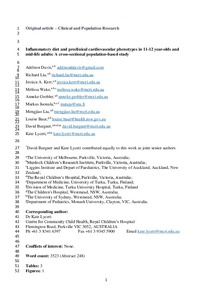Inflammatory diet and preclinical cardiovascular phenotypes in 11–12 year-olds and mid-life adults: A cross-sectional population-based study
Addison Davis; Richard Liu; Jessica A.Kerr; Melissa Wake; Anneke Grobler; Markus Juonala; Mengjiao Liu; Louise Baur; David Burgner; Kate Lycett
https://urn.fi/URN:NBN:fi-fe2021042823710
Tiivistelmä
Background and aims: Pro-inflammatory diet may be a modifiable risk factor for cardiovascular disease. We examine associations of two inflammatory diet scores with preclinical cardiovascular phenotypes at two life course stages.
Methods: Participants: 1771 children (49% girls) aged 11–12 years and 1793 parents (87% mothers, mean age 43.7 (standard deviation 5.2) years) in the Child Health CheckPoint Study. Measures: 23 items in the Australian National Secondary Students' Diet and Activity (NaSSDA) survey were used to derive two inflammatory diet scores based on: 1) published evidence of associations with C-reactive protein (literature-derived score), and 2) empirical associations with CheckPoint's inflammatory biomarker (glycoprotein acetyls, GlycA-derived score). Cardiovascular phenotypes assessed vascular structure (carotid intima-media thickness, retinal vessel calibre) and function (pulse wave velocity, blood pressure). Analyses: Linear regression models were conducted, adjusted for age, sex, socioeconomic position and child pubertal status, plus a sensitivity analysis also including BMI (z-score for children).
Results: In adults, both inflammatory diet scores showed small associations with adverse cardiovascular function and microvascular structure. Per standard deviation higher GlycA-derived diet score, pulse wave velocity was 0.17 m/s faster (95% CI 0.11 to 0.22), mean arterial pressure was 1.85 mmHg (1.34–2.37) higher, and retinal arteriolar calibre was 1.29 μm narrower (−2.10 to −0.49). Adding BMI to models attenuated associations towards null. There was little evidence of associations in children.
Conclusions: Our findings support cumulative adverse effects of a pro-inflammatory diet on preclinical cardiovascular phenotypes across the life course. Associations evident by mid-life were not present in childhood, when preventive measures should be instituted.
Kokoelmat
- Rinnakkaistallenteet [27094]
